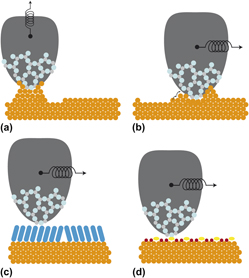Crossref Citations
This article has been cited by the following publications. This list is generated based on data provided by
Crossref.
Nguyen, Huu Chuong
Szyja, Bartłomiej M.
and
Doltsinis, Nikos L.
2014.
Electric conductance of a mechanically strained molecular junction from first principles: Crucial role of structural relaxation and conformation sampling.
Physical Review B,
Vol. 90,
Issue. 11,
Iqbal, Shahid
Wezisla, Sabine
Podgaynyy, Nikolay
and
Baltruschat, Helmut
2015.
Pyridine on Au(111): A frictional transition controlled by electrochemical potential.
Electrochimica Acta,
Vol. 186,
Issue. ,
p.
427.
Cihan, Ebru
Özoğul, Alper
and
Baykara, Mehmet Z.
2015.
Structure and nanotribology of thermally deposited gold nanoparticles on graphite.
Applied Surface Science,
Vol. 354,
Issue. ,
p.
429.
Brinckmann, Steffen
Fink, Caroline A.C.
and
Dehm, Gerhard
2015.
Nanotribology in austenite: Normal force dependence.
Wear,
Vol. 338-339,
Issue. ,
p.
430.
Podgaynyy, Nikolay
Iqbal, Shahid
and
Baltruschat, Helmut
2015.
Friction force microscopy at a regularly stepped Au(665) electrode: Anisotropy effects.
Surface Science,
Vol. 631,
Issue. ,
p.
67.
Podgaynyy, Nikolay
Wezisla, Sabine
Molls, Christoph
Iqbal, Shahid
and
Baltruschat, Helmut
2015.
Stick–slip behaviour on Au(111) with adsorption of copper and sulfate.
Beilstein Journal of Nanotechnology,
Vol. 6,
Issue. ,
p.
820.
de Wijn, A S
Fasolino, A
Filippov, A E
and
Urbakh, M
2016.
Effects of molecule anchoring and dispersion on nanoscopic friction under electrochemical control.
Journal of Physics: Condensed Matter,
Vol. 28,
Issue. 10,
p.
105001.
Caron, Arnaud
2018.
Contact and Fracture Mechanics.
Hausen, Florian
2018.
Advanced Analytical Methods in Tribology.
p.
247.
Ko, H. E.
Kwan, S. G.
Park, H. W.
and
Caron, A.
2018.
Chemical effects on the sliding friction of Ag and Au(111).
Friction,
Vol. 6,
Issue. 1,
p.
84.
Park, Inhee
Hausen, Florian
and
Baltruschat, Helmut
2022.
Friction on I‐Modified Au(111) in a Tetraglyme Electrolyte.
ChemElectroChem,
Vol. 9,
Issue. 9,
Xu, Rong-Guang
Zhang, Gunan
Xiang, Yuan
Garcia, Jonathan
and
Leng, Yongsheng
2022.
Will Polycrystalline Platinum Tip Sliding on a Gold(111) Surface Produce Regular Stick–Slip Friction?.
Langmuir,
Vol. 38,
Issue. 22,
p.
6808.
He, Yang
She, Dingshun
Liu, Zhenyu
Wang, Xiang
Zhong, Li
Wang, Chongmin
Wang, Guofeng
and
Mao, Scott X.
2022.
Atomistic observation on diffusion-mediated friction between single-asperity contacts.
Nature Materials,
Vol. 21,
Issue. 2,
p.
173.
Xu, Rong-Guang
Zhang, Gunan
Xiang, Yuan
and
Leng, Yongsheng
2023.
On the Friction Behavior of SiO2 Tip Sliding on the Au(111) Surface: How Does an Amorphous SiO2 Tip Produce Regular Stick–Slip Friction and Friction Duality?.
Langmuir,
Vol. 39,
Issue. 18,
p.
6425.
